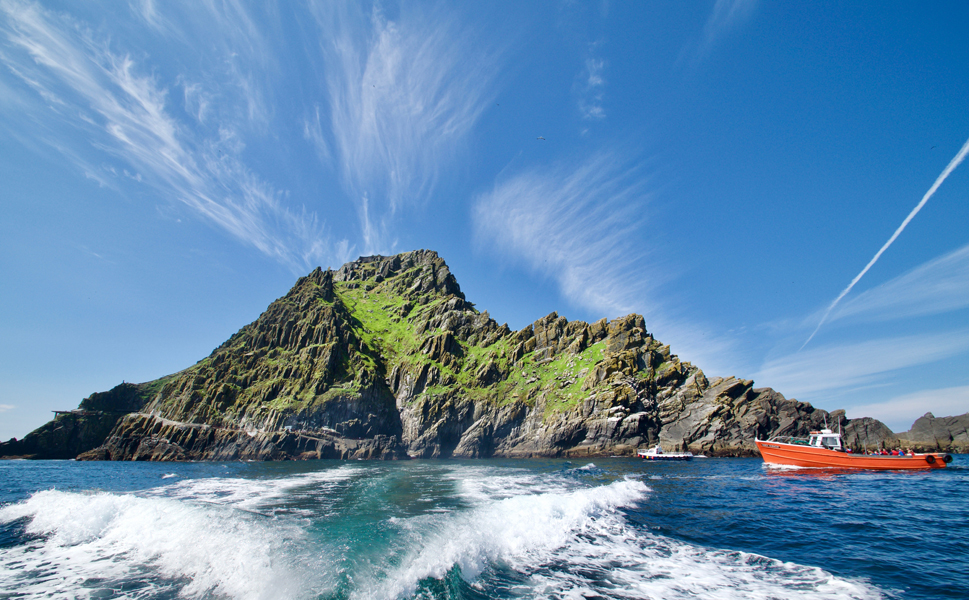Skellig Michael, also known as Great Skellig, is an island on the southwest coast of Ireland. Together with Little Skellig, it forms the archipelago of the Skellig Islands, off the Iveragh peninsula in County Kerry, Munster. Rising steeply 218 meters above the Atlantic Ocean.
Situated on a narrow ledge, approximately 200 meters above water, the smaller monastery is the same as when it was built over 1400 years ago. This monastery is perched on a spectacular elevation of Skellig Michael. There are about 500 stones in Skellig Michael that were placed in their original place by monks, and these stones lead to a narrow ridge called the “saddle of Christ”.
In the 19th century, two lighthouses were built on the island at once, and then a small settlement appeared there, in which the families of the caretakers lived. One of the lighthouses (in the southern part of the island) functions to this day, but already in automatic mode – since the mid-1980s, Skellig Michael has been uninhabited again
From the ancient monastery there are only ruins scattered among the emerald-green wastelands, included in the UNESCO World Heritage List.
They are the main attraction of the island, a magnet for tourists. This renowned monastery is recognized one of the most famous and one of the most difficult to access monasteries in Europe,
Access : Coordinates: 51.771111, -10.540556 / Skellig Michael is located in the Atlantic Ocean , 8 miles off the coast of County Kerry (in southwest Ireland) ,You can get to the island only with a guided tour. Today this distance can be easily covered by boat in 45 minutes,
/ The island is accessible by boat from Portmagee, Ballinskelligs, Caherdaniel and Knightstown (Valentia Island), the crossing of approximately 11 km allowing to skirt Little Skellig and to see its colonies of gannets. Skellig Michael only accessible in good weather, between May and September.
Highlights :
- Local tradition attributes the founding of the monastery to Saint Fionan, who lived around the year 500. It is one of the most remote monasteries in the entire Christian world.
- The monastery is located on the northeast peak, on a sloping rocky plateau. It is made up of two enclosures. Such a location makes it possible to provide shelter, to have water resources and to have the stone to build the monastery .The monks built terraces on which they built their buildings in the inner enclosure, while the outer enclosure served as gardens for cultivation,You can see the six stone conical huts or clochans where they lived, as well as two oratories to pray. The huts are circular on the outside and rectangular on the inside. Its construction was carried out with great care so that rainwater did not seep through the stones. The monks also built cultivation terraces around their settlements.
The site also has two oratories. The large oratory has the traditional shape of an overturned boat hull, while the smaller, more recent, has been more carefully constructed. - The church of Saint-Michel is, unlike the oratories, rectangular. It was probably built in two phases: initially consisting of a small church in stone and mortar, it was subsequently enlarged using blocks. sandstone. The church probably had a wooden roof
- The Hermitage is located just below South Peak. It is accessible by the more recent of the two roads leading to the summitC 4. It is built on terraces hewn from the rock and leveled by dry stones supporting the wall.
- Stairs and paths :There are three main staircases: North Steps (north staircase), South Steps (south staircase) and East Steps (east staircase), leading to the monastery.In addition to the three staircases already in existence at the time of the monks, the lighthouse builders constructed a road known as the Lighthouse Road (“lighthouse road”) along the south and west coasts of the island.
- This small steep rock with sparsely vegetated habitats also constitutes, along with the neighboring island, a sanctuary for the protection of seabirds, hosting large and very diverse populations.
- “The most fantastic and unimaginable rock in the world” – this is how Bernard Shaw spoke of Skellig-Michael when he visited the island at the end of the 19th century.
- Part of the plot of the early medieval novel Le remords de Dieu by Marc Paillet also takes place in the Skellig monastery.
- Songs called “Skellig” were released in 1987 by the Irish band Clannad and in 1997 by the Canadian singer Loreena McKennitt.
- The island was a filming location for the films Star Wars: The Force Awakens and Star Wars: The Last Jedi and served as the backdrop for Luke Skywalker’s hiding place. Since no filming was possible in the medieval monastery complex, it was partially rebuilt for further recordings on the mainland on the Dingle Peninsula.
- The island is one of the settings in the historical crime novel about the nun Fidelma Tod in the scriptorium by Peter Tremayne.
Go next : Wailing Woman , a rock formation along the South Steps. / Lemon Rock / Little Skellig / Puffin Island.

